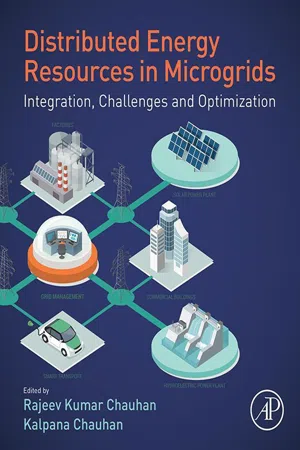
Distributed Energy Resources in Microgrids
Integration, Challenges and Optimization
- 554 pages
- English
- ePUB (mobile friendly)
- Available on iOS & Android
Distributed Energy Resources in Microgrids
Integration, Challenges and Optimization
About this book
Distributed Energy Resources in Microgrids: Integration, Challenges and Optimization unifies classically unconnected aspects of microgrids by considering them alongside economic analysis and stability testing. In addition, the book presents well-founded mathematical analyses on how to technically and economically optimize microgrids via distributed energy resource integration. Researchers and engineers in the power and energy sector will find this information useful for combined scientific and economical approaches to microgrid integration.Specific sections cover microgrid performance, including key technical elements, such as control design, stability analysis, power quality, reliability and resiliency in microgrid operation.- Addresses the challenges related to the integration of renewable energy resources- Includes examples of control algorithms adopted during integration- Presents detailed methods of optimization to enhance successful integration
Frequently asked questions
- Essential is ideal for learners and professionals who enjoy exploring a wide range of subjects. Access the Essential Library with 800,000+ trusted titles and best-sellers across business, personal growth, and the humanities. Includes unlimited reading time and Standard Read Aloud voice.
- Complete: Perfect for advanced learners and researchers needing full, unrestricted access. Unlock 1.4M+ books across hundreds of subjects, including academic and specialized titles. The Complete Plan also includes advanced features like Premium Read Aloud and Research Assistant.
Please note we cannot support devices running on iOS 13 and Android 7 or earlier. Learn more about using the app.
Information
Microgrids architectures
Abstract
Keywords
1.1 Introduction

1.2 Literature review of microgrid studies
Table of contents
- Cover image
- Title page
- Table of Contents
- Copyright
- List of contributors
- Preface
- Acknowledgments
- Chapter 1. Microgrids architectures
- Chapter 2. Distributed energy resources and control
- Chapter 3. Use of agents for isolated microgrids with frequency regulation
- Chapter 4. Su-Do-Ku and symmetric matrix puzzles–based optimal connections of photovoltaic modules in partially shaded total cross-tied array configuration for efficient performance
- Chapter 5. Dynamics of power flow in a stand-alone microgrid using four-leg inverters for nonlinear and unbalanced loads
- Chapter 6. Lithium-ion batteries as distributed energy storage systems for microgrids
- Chapter 7. Impact of dynamic performance of batteries in microgrids
- Chapter 8. Photovoltaic array reconfiguration to extract maximum power under partially shaded conditions
- Chapter 9. Communications and internet of things for microgrids, smart buildings, and homes
- Chapter 10. Communications, cybersecurity, and the internet of things for microgrids
- Chapter 11. Transmission system-friendly microgrids: an option to provide ancillary services
- Chapter 12. Energy management of various microgrid test systems using swarm evolutionary algorithms
- Chapter 13. Development of the synchronverter for green energy integration
- Chapter 14. Power converter solutions and controls for green energy
- Chapter 15. Safety and reliability evaluation for electric vehicles in modern power system networks
- Chapter 16. Load forecasting using multiple linear regression with different calendars
- Chapter 17. Unintentional islanding detection
- Chapter 18. An analysis of the current- and voltage current–based characteristics’ impact on relay coordination for an inverter-faced distributed generation connected network
- Chapter 19. On the topology for a smart direct current microgrid for a cluster of zero-net energy buildings
- Chapter 20. Energy-management solutions for microgrids
- Index